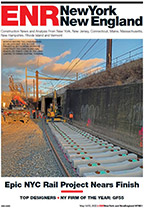NYC Crane Rescue Is Complete

Updated: Construction crews successfully tethered a dangling tower crane on West 57th Street in Midtown Manhattan on Nov. 3, allowing nearby buildings to re-open.
Using a wrench on the turntable's pinion gear, workers hand-cranked the jib closer to the One57 building and then used cables to tie down the boom. Residents were soon after allowed to re-enter nearby buildings, which were closed for days after Hurricane Sandy struck the region.
Emergency repair work began earlier that day at the under-construction One57 tower in Midtown Manhattan, whose 1,000-ft-tall tower crane was left dangling in the winds days after Hurricane Sandy hit the region. On Nov. 2, crews had devised a plan to rescue the dangling crane, said New York City Mayor Michael Bloomberg.
"It's an approximately 36-hour operation," Bloomberg said immediately prior to the work. "The goal is to remove the vacate order and allow people in the vicinity to return to their homes and their offices by Monday night."
The One57 unit appears to be the only tower crane damaged during Sandy, Jay P. Shapiro, crane engineer and vice president of New York-based Howard I. Shapiro & Associates, told ENR.
"It's the only one that we are aware of," said Shapiro in a Nov. 2 phone interview. The city's Dept. of Buildings directed the firm after the storm to inspect the dozen-or-so tower cranes operating in the city, including cranes operating at the World Trade Center site.
Shapiro's brother, Lawrence, who helped engineer the 57th Street crane rescue plan, said the cable ties used to tether the crane will provide a "belt and suspenders" restraint against gravity and lateral loads, though the risk of the roughly 25,000-pound boom falling is low.
"The two chords are still intact, and they are plenty strong to hold the weight of the boom," he told ENR in a phone interview.
The city's buildings department did not respond to questions about the rescue plan but confirmed that wind factors, not operational ones, appeared to be the cause of the partial collapse.
"At this time, there is no indication anything was done improperly," Tony Sclafani, spokesman for DOB, wrote in an e-mail.





